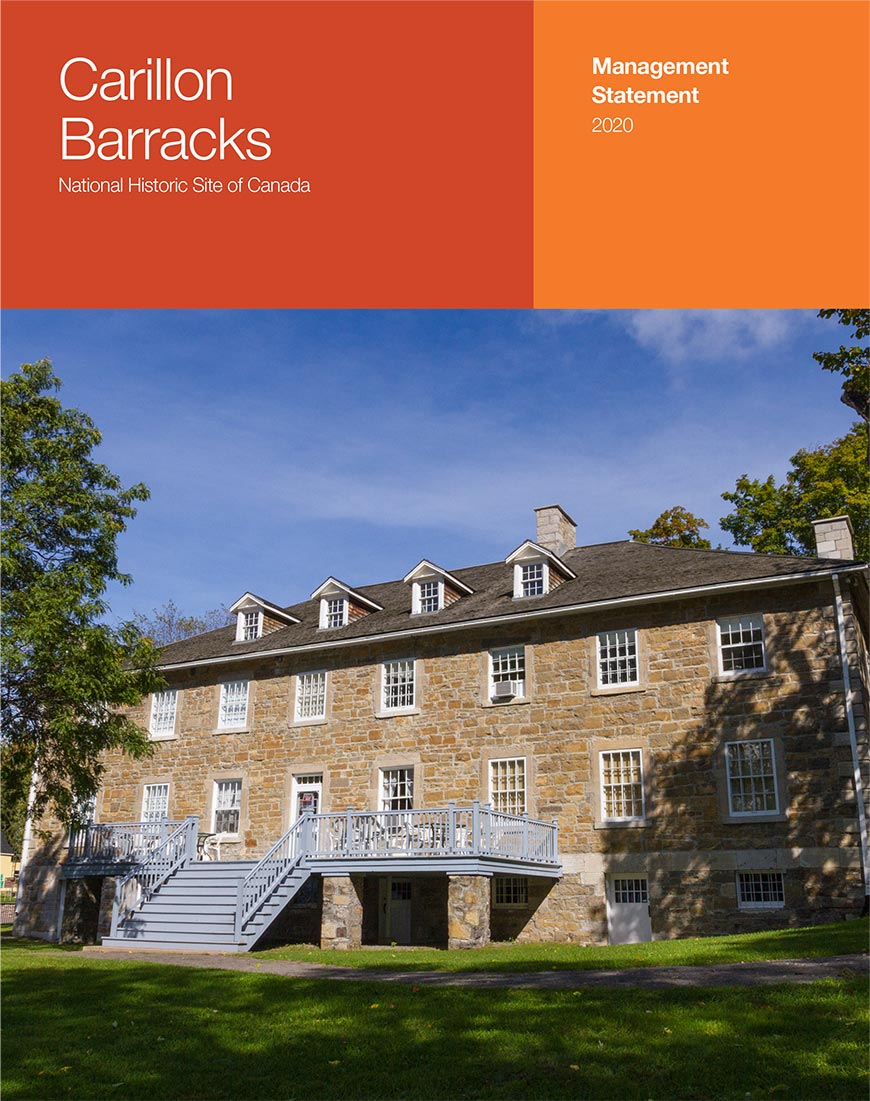
Carillon Barracks National Historic Site Management Statement 2020
Carillon Barracks National Historic Site
- Carillon Barracks Management Statement (PDF, 1,5 MB)
Table of contents

© Her Majesty the Queen in Right of Canada, as represented by the Chief Executive Officer of the Parks Canada Agency, 2020.
Cette publication est aussi disponible en français.
Énoncé de gestion du lieu historique national de la Caserne-de-Carillon
Library and Archives Canada Cataloguing in Publication
- Parks Canada
Issued also in French under the title:
Énoncé de gestion du lieu historique national du Canada de la Caserne-de-Carillon
For more information about the management statement or about
Saint-André-d’Argenteuil (Québec) J0V 1X0
Recommendations
Recommended and original signed by:
Nadine Blackburn
Field Unit Superintendent
La Mauricie and Western Quebec
Parks Canada
Context
Parks Canada manages a network of one of the world's most breathtaking and extensive historic sites. Its mandate is to protect and showcase these sites for the benefit of present and future generations. This management statement details Parks Canada’s management approach and outlines specific goals for Carillon Barracks National Historic Site.
Carillon Barracks National Historic Site is located on the banks of the Ottawa River, in the municipality of Saint-André-d’Argenteuil. The Carillon Barracks was declared a National Historic Site in 1960 for the following reasons:
« it is an excellent example of military architecture »
« it is associated with the construction of a network of military canals on the Rideau and Ottawa Rivers »
« it is associated with the 1837 rebellion »
The building was originally built between 1830 and 1837, after Ottawa’s first canal system was installed. Charles John Forbes, Deputy Commissary General of Her Majesty’s Army, first erected it to serve as a residential and commercial building. In 1837, it was requisitioned and enlarged by the British army to house troops fighting the Patriots’ War. Three years later, the barracks regained its civilian status. After being abandoned for some years, the Barracks were purchased in 1937 by the federal government and leased to the Argenteuil Historical Society, which opened a museum there in 1939. To date, the location, owned by Parks Canada, has been operated by the Argenteuil Regional Museum.
The National Historic Site is usually open to the public from Wednesday to Sunday from June to September, and Sundays only in September and October. On average, it welcomes 1,500 visitors annually, mostly individual visitors and school groups (10–20% annually).
Due to its proximity to the Ottawa River, the barracks are vulnerable to flooding. In recent years, flooding has become more frequent and water levels higher. The 2017 and 2019 floods accelerated deterioration of the structure, which will require major work over the next few years. This is why occupying the building is not possible until work is completed. As a result, Parks Canada has entered into discussions with the regional museum’s partners and stakeholders to facilitate the transition during the relocation of the museum in coming years. During this time, information on the heritage and historical significance of the Barracks will be available on the National Historic Site website.
Management Approach
Parks Canada’s priority is to maintain the integrity of the national historic site by repairing the barracks and carrying out work to make the site more flood-resilient. The site will remain a protected heritage space for current and future generations. When the time is right, Parks Canada will collaborate with community stakeholders to allow public access to the site and to commemorative messages.
Management Goals
Resource Conservation:
Parks Canada protects the cultural resources in its heritage sites in accordance with the Cultural Resource Management Policy and the Standards and Guidelines for the Conservation of Historic Places in Canada. The goal of the Carillon Barracks National Historic Site is to maintain the site’s commemorative integrity for current and future generations by pursuing cultural preservation efforts. Completing building repairs and carrying out flood-resiliency work are priorities. Parks Canada will provide on-going oversight and document any work related to cultural resources. Parks Canada also plans to finalize the site’s commemorative integrity statement. Finally, any action that might negatively affect cultural resources will be subject to an impact assessment, as stipulated in the Cultural Resource Management Policy.
Relationships with local and regional partners:
During the closure, Parks Canada will support the Argenteuil Regional Museum to its best capacity, including relocating and storing collections. Once work is completed and conditions permit, Parks Canada will establish, in consultation with its partners and the community, a collaborative approach for allowing the public access to the site and commemorative messages.
Public understanding and appreciation:
Parks Canada provides information about the importance of the Carillon Barracks National Historic Site on its website and in the Canadian Register of Historic Places. The Agency will work collaboratively to enhance Parks Canada’s brand presence at the historic site by highlighting its leadership in conservation and heritage presentation.
- Date modified :